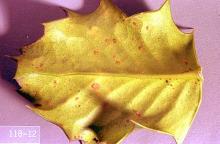Brown soft scale (Coccus hesperidum)
Holly scale (Dynaspidiotus britannicus)
Pest description and damage Scale insects are small (less than 0.125 inch in length) soft insects that live beneath waxy scales. These insects are often identified by the shape and size of their scales, the description of adult males and females, immature crawler stage, color of eggs, and host plant preferences. Brown soft scales are flat, yellowish to dark brown, somewhat mottled insects that range from 0.1 to 0.2 inch in length. They are found on twigs, although young scales also may be found on the foliage, typically on the underside of leaves and along veins. Scale insects suck plant sap and produce copious honeydew on which sooty mold may grow. Brown soft scale has a wide host range. There are multiple generations per year. The holly scale insect is a small (0.04 inch in diameter) oval scale, light brown to tan in color. The adult female is lemon yellow. Scale feeding can cause the upper surface of the leaves to become mottled and plant defoliation may occur. Heavily infested plants can be coated with honeydew on which black sooty mold develops. Heavy infestations can weaken plants and make the holly useless as holiday greens.
Biology and life cycle The holly scale insect overwinters as an immature scale. In spring, the nymphs mature and begin feeding in late March or early April. The adult males emerge from under their scales and fly to find the adult females in May. Eggs are laid in early- to mid-summer. Around two weeks later the eggs hatch and begin to disperse to foliage throughout the tree. There is only one generation per year.
For monitoring and management
See "Scale insect" in:
Management-chemical control
See Table 1 in:

